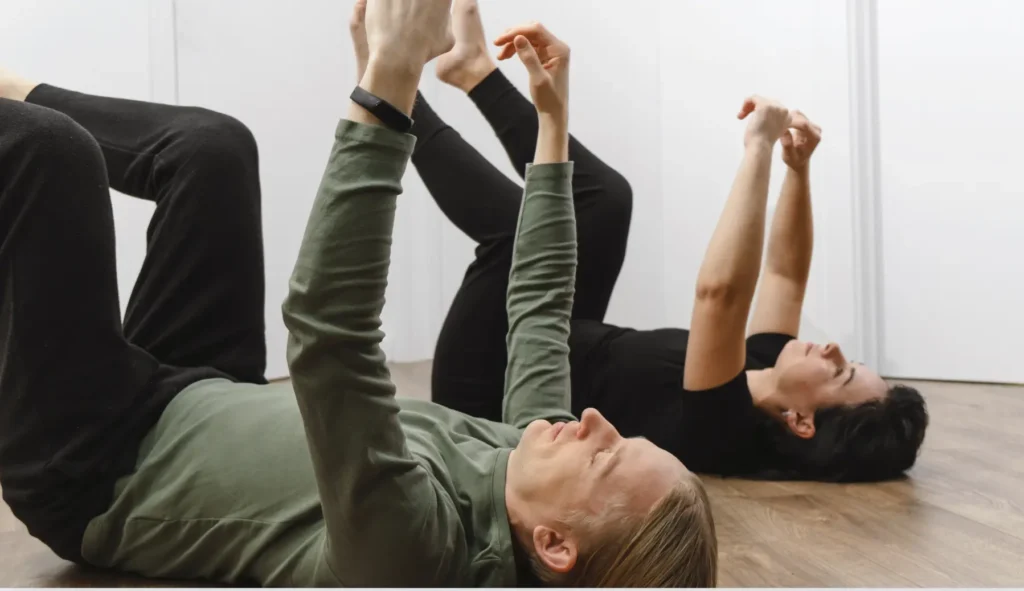I’m wrapping up a four-week sleep camp (1 class/week) with my Feldenkrais teacher, Sandy Weiss, from Mind Body Science Works. Before I begin, let me share a bit about what Feldenkrais is! Feldenkrais is an approach to movement education that focuses on improving body awareness and function through gentle, mindful movement exercises. Developed by Moshé Feldenkrais, it aims to help individuals develop more efficient and effective movement patterns.
The method is designed to address a range of issues, including:
- Chronic Pain: By improving movement patterns, it can help alleviate discomfort and reduce pain.
- Posture and Alignment: It helps in correcting poor posture and alignment by increasing awareness of body mechanics.
- Movement Efficiency: It enhances overall movement efficiency, which can be beneficial for athletes or anyone looking to improve their physical performance.
- Stress and Tension: The mindful approach can reduce stress and physical tension by promoting relaxation and body awareness.
- Rehabilitation: It can support recovery from injuries by facilitating better movement habits and reducing strain on injured areas.
The Feldenkrais Method also can help with sleep! Check out the 3 things I’ve learned about setting myself up for sleep that’ve made a meaningful difference in both the quantity and quality of my rest.

1. Day Tamers: Small Practices, Big Impact
Day tamers are small practices you can do during the day that help your body wind down before it’s actually time to sleep. They take as little as one to two minutes, and while they do help with sleep, I’ve found that they’re even more effective for offloading my stress and anxiety through the day. This was an unexpected benefit for me. These practices are also great for those early morning wake-ups, around 3 AM, when falling back asleep feels impossible. One of my favorites is the “Main Squeeze” described below. These directions were written up by my practitioner Sandy, and I had permission to share:
The Main Squeeze: Day TamerTM
This can be done in the day or night sitting or lying. You can place a pillow or blanket in
your lap for comfort. It can be done in the middle of the night to bring you back to
sleep or start you on your way. We use the “secret handshake.” Place both hands in
front of you palms down with the thumbs pointing toward each other. With one hand
grasp the other thumb like the handlebar of a bicycle. With the grasping hand, extend
the pointer finger into the palm of the other hand and fold over the remaining fingers.
Now rest your hands in your lap or on your belly. Rest quietly like this with easy gentle
hands. Notice the coming and going of your breath and the sensation of your hands.
Gently begin squeezing with one hand only for a 10 or so breaths on the exhale while
releasing the squeeze on the inhale. Rest. Sense how your breath or your general sense
of yourself may have changed. Now do the same thing squeezing with the other hand
for 10 or so breaths. Rest. Now alternate squeezing with one hand then the other.
Rest and notice how you feel.
2. Abundance vs. Scarcity Mindset
Another powerful lesson was shifting my mindset from scarcity to abundance when it comes to sleep. Our bodies constantly cycle through four states: thinking, emotions, sensation, and movement. Thoughts and emotions can activate our sympathetic nervous system, putting us on high alert and making it harder to fall asleep. In contrast, focusing on sensations and gentle movements can help us calm down and relax.
I’ve noticed that many of my sleep issues stemmed from a scarcity mindset or anxious thoughts—either about not being able to fall asleep or worrying about the next day if I didn’t get enough rest. Now, when I catch myself ruminating in my head, I focus on getting into my body. Here are a few things I do, whether I’m in or out of bed, to support this shift:
LESS is more: Guided Natural BreathingTM
Breathing for sleep is Light, Easy, Slow, & Soft. Make no effort to breath in any special
way. Usually done lying on your back let the breath come and go. Start with hands on
the belly noticing the sensation in the hands fingers close or touching. Then rest.
Notice any change. Move hands to lower ribs and sense the flow of your breath and
movement of your hands. Rest. Notice any change. Move your hands to the upper ribs.
Follow the ribs with your hands. Rest. Notice the change. Notice the pleasure.
3. Setting an Intention to Rest
When I get into bed, Sandy helped me set a simple intention: I’m here to rest and find peace. This shifts me into an abundant mindset, where I have plenty of time to relax and enjoy my bed, without stressing about the need to sleep. The more we strive for something, the harder it becomes, so I’ve stopped striving for sleep. I’ve accepted that some nights will be better than others, and letting go of the pressure to have a perfect night’s sleep has made a noticeable difference.
The following is a practice to remind the mind… “not now.” 🙂
Mind Management: “The Power of Not Now.”TM
Set your concerns aside think “nothing in particular.” Remind yourself that you are here for
“rest only.” Notice your breath. “I choose quiet rest. Nothing else is required of me.” On
inhale, your breath makes the sound “not.” On exhale your breath makes the sound, “now.”
Repeat.
I hope these insights help you as much as they’ve helped me. Remember, it’s not just about the time you spend in bed, but the mindset and practices you bring into your daily life that truly support restful sleep.
Wishing you peaceful nights and calm days ahead!

